英语手抄报内容春节
无论是在学校还是在社会中,大家最不陌生的就是手抄报了吧,借助手抄报可以有效培养我们的动手动脑能力。那么问题来了,到底什么样的手抄报才经典呢?下面是小编整理的英语手抄报内容春节,仅供参考,欢迎大家阅读。
英语手抄报内容春节
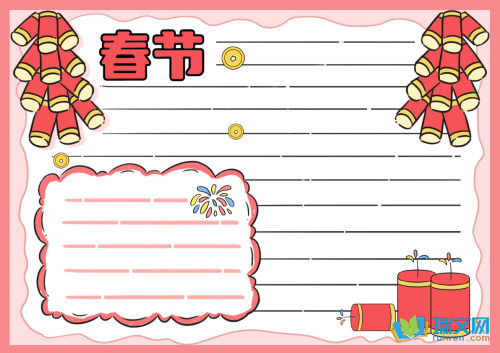
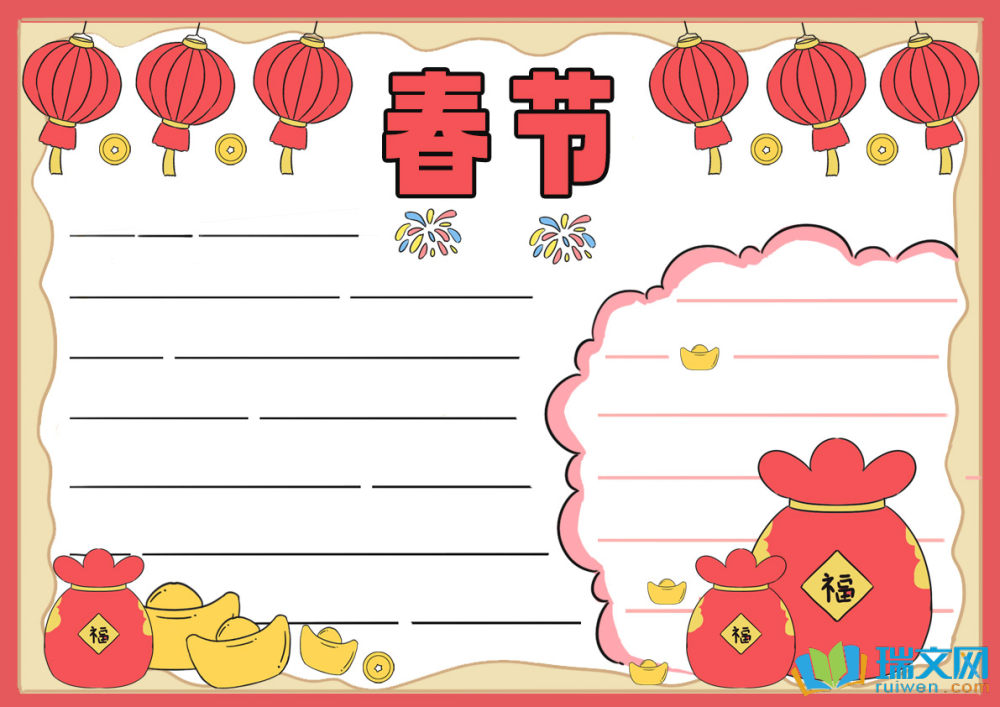
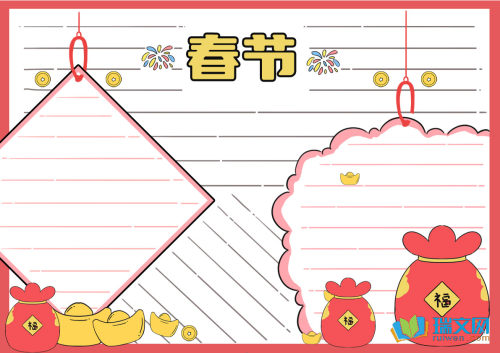
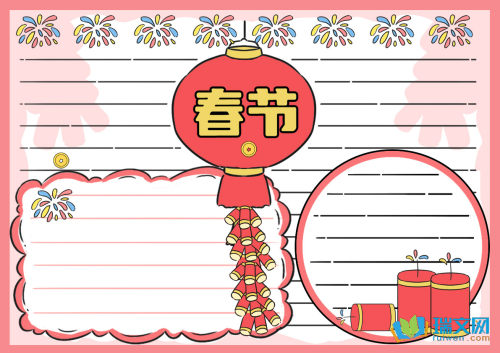
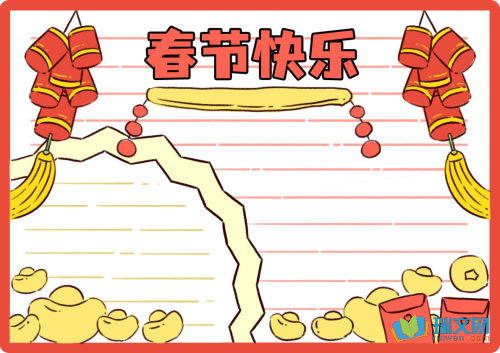
春节英语手抄报1
春节英语手抄报2
春节英语手抄报3
春节英语手抄报4
春节英语手抄报5
春节(The Spring Festival)英文介绍
The Spring Festival is the most important festival for the Chinese people and is when all family members get together, just like Christmas in the West. All people living away from home go back, becoming the busiest time for transportation systems of about half a month from the Spring Festival. Airports, railway stations and long-distance bus stations are crowded with home returnees.
Strictly speaking, the Spring Festival starts every year in the early days of the 12th lunar month and will last till the mid 1st lunar month of the next year. Of them, the most important days are Spring Festival Eve and the first three days. The Chinese government now stipulates people have seven days off for the Chinese Lunar New Year.
Many customs accompany the Spring Festival. Some are still followed today, but others have weakened.
On the 8th day of the 12th lunar month, many families make laba porridge, a delicious kind of porridge made with glutinous rice, millet, seeds of Job's tears, jujube berries, lotus seeds, beans, longan and gingko.
The 23rd day of the 12th lunar month is called Preliminary Eve. At this time, people offer sacrifice to the kitchen god. Now however, most families make delicious food to enjoy themselves.
After the Preliminary Eve, people begin preparing for the coming New Year. This is called “Seeing the New Year in”.
Store owners are busy then as everybody goes out to purchase necessities for the New Year. Materials not only include edible oil, rice, flour, chicken, duck, fish and meat, but also fruit, candies and kinds of nuts. What's more, various decorations, new clothes and shoes for the children as well as gifts for the elderly, friends and relatives, are all on the list of purchasing.
Before the New Year comes, the people completely clean the indoors and outdoors of their homes as well as their clothes, bedclothes and all their utensils.
Then people begin decorating their clean rooms featuring an atmosphere of rejoicing and festivity. All the door panels will be pasted with Spring Festival couplets, highlighting Chinese calligraphy with black characters on red paper. The content varies from house owners' wishes for a bright future to good luck for the New Year. Also, pictures of the god of doors and wealth will be posted on front doors to ward off evil spirits and welcome peace and abundance.
The Chinese character “fu” (meaning blessing or happiness) is a must. The character put on paper can be pasted normally or upside down, for in Chinese the “reversed fu” is homophonic with “fu comes”, both being pronounced as “fudaole.” What's more, two big red lanterns can be raised on both sides of the front door. Red paper-cuttings can be seen on window glass and brightly colored New Year paintings with auspicious meanings may be put on the wall.
People attach great importance to Spring Festival Eve. At that time, all family members eat dinner together. The meal is more luxurious than usual. Dishes such as chicken, fish and bean curd cannot be excluded, for in Chinese, their pronunciations, respectively “ji”, “yu” and “doufu,” mean auspiciousness, abundance and richness. After the dinner, the whole family will sit together, chatting and watching TV. In recent years, the Spring Festival party broadcast on China Central Television Station (CCTV) is essential entertainment for the Chinese both at home and abroad. According to custom, each family will stay up to see the New Year in.
Waking up on New Year, everybody dresses up. First they extend greetings to their parents. Then each child will get money as a New Year gift, wrapped up in red paper. People in northern China will eat jiaozi, or dumplings, for breakfast, as they think “jiaozi” in sound means “bidding farewell to the old and ushering in the new”. Also, the shape of the dumpling is like gold ingot from ancient China. So people eat them and wish for money and treasure.
Southern Chinese eat niangao (New Year cake made of glutinous rice flour) on this occasion, because as a homophone, niangao means “higher and higher, one year after another.” The first five days after the Spring Festival are a good time for relatives, friends, and classmates as well as colleagues to exchange greetings, gifts and chat leisurely.
Burning fireworks was once the most typical custom on the Spring Festival. People thought the spluttering sound could help drive away evil spirits. However, such an activity was completely or partially forbidden in big cities once the government took security, noise and pollution factors into consideration. As a replacement, some buy tapes with firecracker sounds to listen to, some break little balloons to get the sound too, while others buy firecracker handicrafts to hang in the living room.
The lively atmosphere not only fills every household, but permeates to streets and lanes. A series of activities such as lion dancing, dragon lantern dancing, lantern festivals and temple fairs will be held for days. The Spring Festival then comes to an end when the Lantern Festival is finished.
China has 56 ethnic groups. Minorities celebrate their Spring Festival almost the same day as the Han people, and they have different customs.
译文:
春节(春节)英文介绍
春节是中国人最重要的节日,是全家人团聚的时候,就像西方的圣诞节一样。所有离开家的人都回去了,成为春节后半个月左右交通系统最繁忙的时候。机场,火车站和长途汽车站都挤满了返乡者。
严格来说,春节每年农历十二月初,一年到一月中旬。其中,最重要的日子是春节前夕和前三天。中国政府现在规定中国农历新年有七天假。春节伴随着许多风俗习惯。有些人今天仍然被追随,但其他人却被削弱了。
农历十二月八日,许多家庭制作腊八粥,这是一种用糯米,小米,薏米种子,枣浆,莲子,豆类,龙眼和银杏制成的美味粥。
农历十二月二十三日称为初夏。这时候,人们向厨神献祭。然而,现在大多数家庭都做出美味的食物来享受自己。初夏前夕,人们开始为即将到来的新年做准备。这就是所谓的“看新年”。
店主们都很忙,因为每个人出去购买新年的必需品。材料不仅包括食用油,大米,面粉,鸡肉,鸭肉,鱼肉,还包括水果,糖果和各种坚果。更何况,各种装饰品,小孩子的新衣服,鞋子,以及老人,亲友的礼物都在采购之列。
新年来临之前,人们彻底清洁了家中的室内外,以及衣服,床上用品和所有的器具。
然后人们开始装饰他们洁净的房间,喜气洋洋的气氛。所有的门板都会贴上春联,在红纸上突出黑字的中国书法。内容因房屋所有者对美好的未来的祝福和新年的.好运而有所不同。此外,门神和财富的照片将张贴在前门,以避免恶灵,欢迎和平和丰富。
中国字“福”(意为祝福或幸福)是必须的。放在纸上的字符可以正常粘贴或颠倒粘贴,因为在中文里“倒赋”与“赋”是谐音的,都是“fudaole”,另外两个大红灯笼可以在两边的前门。在窗户玻璃上可以看到红色的剪纸,墙上挂着带有吉祥意义的色彩鲜艳的年画。
人们非常重视春节前夕。那时候,所有的家庭成员一起吃晚餐。这顿饭比平时更豪华。鸡,鱼,豆腐等菜肴不能排除在外,因为在中国,他们的发音分别是“吉”,“玉”和“豆腐”,意味着吉祥,丰富和丰富。晚餐后,全家人坐在一起,聊天,看电视。近年来,中央电视台播放的春节晚会,对于国内外的中国人来说,是必不可少的娱乐活动。根据习俗,每个家庭都会熬夜去看新年。
新年醒来,每个人都打扮起来。首先他们向父母致意。那么每个孩子都会拿到钱作为新年礼物,用红纸包起来。因为他们认为“j子”的意思是“告别旧事,迎新”,北方人会吃饺子或饺子吃早餐。另外,饺子的形状就像中国古代的金锭。所以人们吃他们,并希望金钱和财富。
南方人在这个时候吃naoao(用糯米粉做的年糕),因为作为一个同音词,nangao意味着“一年又一年越来越高”。春节后的前五天是亲戚的好时机朋友,同学以及同事交流问候,礼物和闲聊。
燃烧的烟花曾经是春节最典型的习俗。人们认为这种spl sound的声音可以驱赶邪灵。但是,一旦政府考虑安全,噪音和污染因素,大城市完全或部分禁止这样的活动。作为替代,一些购买鞭炮的录音带听起来有些咔哒咔哒的破气球,也有人拿起鞭炮手工艺品挂在客厅里。
活泼的气氛不仅填满了每一个家庭,还渗透到街道和巷道。舞狮,龙灯舞,灯会,庙会等一系列活动将持续数日。元宵节结束后,春节即将结束。
中国有56个民族。几乎和汉族人一样,少数民族也过着春节的庆典,他们有不同的习俗。
【英语手抄报内容春节】相关文章:
春节手抄报的英语内容09-04
英语春节手抄报内容01-17
春节的手抄报英语内容09-04
春节英语手抄报内容06-26
春节英语手抄报内容精选08-18
英语春节手抄报的内容06-24
春节英语手抄报内容小学01-03
我的春节英语手抄报内容01-02
春节英语手抄报内容大全08-26